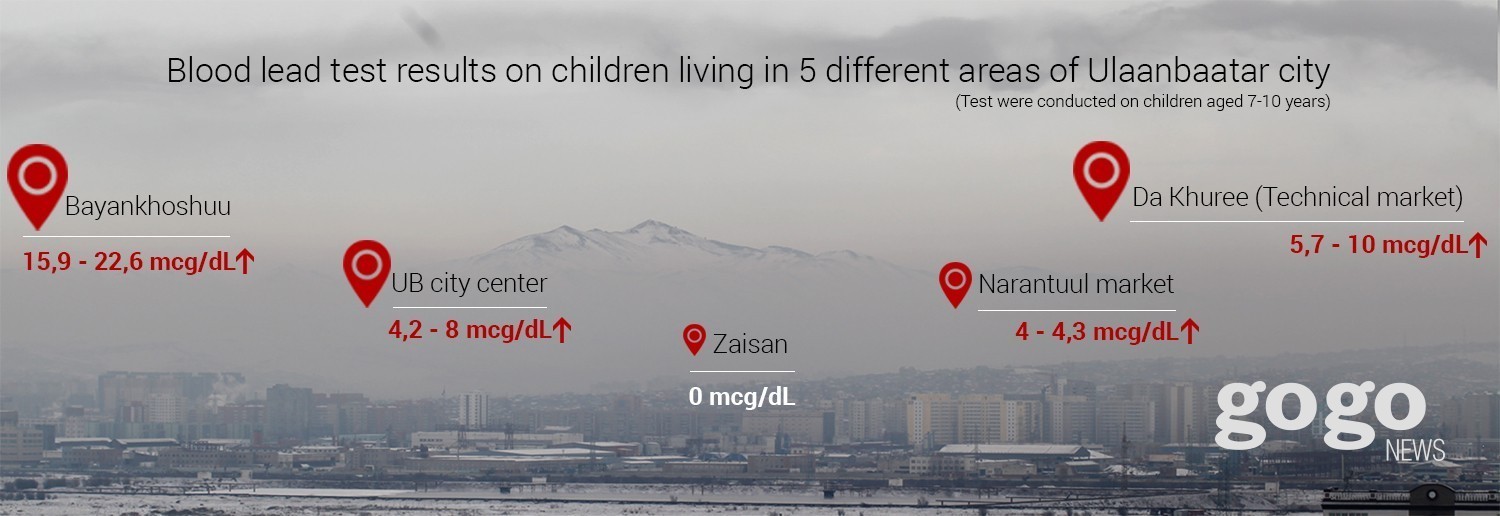
In Feb 2017, GoGo News Agency and Mongolian National University of Medical Sciences conducted blood test on lead involving 15 children aged 7-10 years who are living in 5 different areas of the Ulaanbaatar city including Da khuree, Bayankhoshuu, Narantuul market, City center and Zaisan. The test results were interesting.
5,7-22 µg/dl lead in blood was found from the children living near Da Khuree technical market and Bayankhoshuu, while no lead was found from the child living in Zaisan.
Bayankhoshuu is located in Songinokhairkhan district which covers total of 1200,6 km2 areas and has 82,895 households. However, only one-fourth of the households are living in apartment.
Da khuree technical market is located in Bayanzurkh district where more than half of households live in ger district too. Also, the area is crowded with auto repair centers and washing centers.
Households living in ger district burn raw coal to survive harsh winter which resulting hazardous levels of air pollution almost every day throughout the winter. Scientists reveal that ash from a coal contains lead.
The test reveals that the child living in Bayankhosuu is being poisoned from lead-containing coal, fine particulate matter and lead-containing blue water cans while car oil, automotive battery, leaded gasoline and soil pollution is the reason why child living in Da Khuree technical market has the high level of lead in blood.
Zaisan, a new residential area for upper-class people is located in Khan-Uul district, on the bank of Tuul river and bottom of the Bogd mountain where it has the cleanest air all year round.

Apart from lead-containing ashes, lead was found in soils of the city. According to the study conducted by Institute of Geography and Geoecology, lead concentration was high in soils of several districts which have the highest number of ger district households.
A national standard for a safe level of soil lead is 100 mg/kg. However, the maximum level of soil lead in districts is ranging between 390-2413 mg/kg.
Also, Zaisan has the cleanest soil which amounts 45-110.50 mg/kg. In other words, Zaisan has the cleanest air and soil which might be the reason why no lead was found from a child living in Zaisan.
NEUROLOGICAL DISORDER IN CHILDREN
According to the World Health Organization, there is no known safe blood lead concentration. But it is known that, as lead exposure increases, the range and severity of symptoms and effects also increase. Even blood lead concentrations as low as 5 µg/dl, once thought to be a “safe level”, may result in decreased intelligence in children, behavioral difficulties, and learning problems.
Lead-containing air and soil resulting negative impacts on children`s brain development. Health Development Center reports 761 children in Songinokhairkhan district, 735 children in Bayanzurkh district, 256 children in Khan-Uul district were suffered from nervous system disorders in 2016.
In 2013, total of 498 children suffered from nervous system disorders in Songinokhairkhan district, but this number rose to 761 after three years. Nervous system disorders were relatively low in Khan-Uul district compared to other districts, but it has doubled in just four years.
Increase in nervous system disorders in four years
(during 2012-2016)
The neurological disorder is popular among children living in Songinokhairkhan and Bayanzurkh districts.
Of course, this conclusion should be set based on many factors, including population, population growth, and livelihood. Here we note that it is not a research, it is a hypothesis raised by a reporter.
CONCLUSION
As lead concentrations in the blood increases by 10 µg/dl, children's intellectual potential is reduced by 1-5 score and there are changes in perception and attitude. Thus, we have decided to name lead as a "brain eater".
Americans banned the use of leaded gasoline and stopped using leaded paint in schools since 1970 when they found out that the lead directly affects intelligence quotient of children.
Mongolian research companies and researchers conducted survey on the lead poisoning since 2010, which threatening our children`s future. However, the Ministry of Health and the Government are not taking this issue into account.
GoGo News Agency raised the issue again in Feb 2017 appealing to take a wide range of research and analysis. The Ministry of Health and the Government are still not responding.
Seemingly, it can be said as officials are less concerned about how children's health is being affected by environmental pollution.
The Government urgently needs to conduct blood lead test among all children of the nation and determine the reason for the high lead level in blood as well as to find out solutions.

In Feb 2017, GoGo News Agency and Mongolian National University of Medical Sciences conducted blood test on lead involving 15 children aged 7-10 years who are living in 5 different areas of the Ulaanbaatar city including Da khuree, Bayankhoshuu, Narantuul market, City center and Zaisan. The test results were interesting.
5,7-22 µg/dl lead in blood was found from the children living near Da Khuree technical market and Bayankhoshuu, while no lead was found from the child living in Zaisan.
Bayankhoshuu is located in Songinokhairkhan district which covers total of 1200,6 km2 areas and has 82,895 households. However, only one-fourth of the households are living in apartment.
Da khuree technical market is located in Bayanzurkh district where more than half of households live in ger district too. Also, the area is crowded with auto repair centers and washing centers.
Households living in ger district burn raw coal to survive harsh winter which resulting hazardous levels of air pollution almost every day throughout the winter. Scientists reveal that ash from a coal contains lead.
The test reveals that the child living in Bayankhosuu is being poisoned from lead-containing coal, fine particulate matter and lead-containing blue water cans while car oil, automotive battery, leaded gasoline and soil pollution is the reason why child living in Da Khuree technical market has the high level of lead in blood.
Zaisan, a new residential area for upper-class people is located in Khan-Uul district, on the bank of Tuul river and bottom of the Bogd mountain where it has the cleanest air all year round.

Apart from lead-containing ashes, lead was found in soils of the city. According to the study conducted by Institute of Geography and Geoecology, lead concentration was high in soils of several districts which have the highest number of ger district households.
A national standard for a safe level of soil lead is 100 mg/kg. However, the maximum level of soil lead in districts is ranging between 390-2413 mg/kg.
Also, Zaisan has the cleanest soil which amounts 45-110.50 mg/kg. In other words, Zaisan has the cleanest air and soil which might be the reason why no lead was found from a child living in Zaisan.
NEUROLOGICAL DISORDER IN CHILDREN
According to the World Health Organization, there is no known safe blood lead concentration. But it is known that, as lead exposure increases, the range and severity of symptoms and effects also increase. Even blood lead concentrations as low as 5 µg/dl, once thought to be a “safe level”, may result in decreased intelligence in children, behavioral difficulties, and learning problems.
Lead-containing air and soil resulting negative impacts on children`s brain development. Health Development Center reports 761 children in Songinokhairkhan district, 735 children in Bayanzurkh district, 256 children in Khan-Uul district were suffered from nervous system disorders in 2016.
In 2013, total of 498 children suffered from nervous system disorders in Songinokhairkhan district, but this number rose to 761 after three years. Nervous system disorders were relatively low in Khan-Uul district compared to other districts, but it has doubled in just four years.
Increase in nervous system disorders in four years
(during 2012-2016)
The neurological disorder is popular among children living in Songinokhairkhan and Bayanzurkh districts.
Of course, this conclusion should be set based on many factors, including population, population growth, and livelihood. Here we note that it is not a research, it is a hypothesis raised by a reporter.
CONCLUSION
As lead concentrations in the blood increases by 10 µg/dl, children's intellectual potential is reduced by 1-5 score and there are changes in perception and attitude. Thus, we have decided to name lead as a "brain eater".
Americans banned the use of leaded gasoline and stopped using leaded paint in schools since 1970 when they found out that the lead directly affects intelligence quotient of children.
Mongolian research companies and researchers conducted survey on the lead poisoning since 2010, which threatening our children`s future. However, the Ministry of Health and the Government are not taking this issue into account.
GoGo News Agency raised the issue again in Feb 2017 appealing to take a wide range of research and analysis. The Ministry of Health and the Government are still not responding.
Seemingly, it can be said as officials are less concerned about how children's health is being affected by environmental pollution.
The Government urgently needs to conduct blood lead test among all children of the nation and determine the reason for the high lead level in blood as well as to find out solutions.


